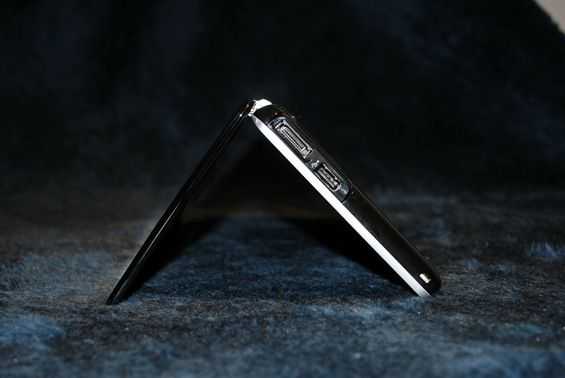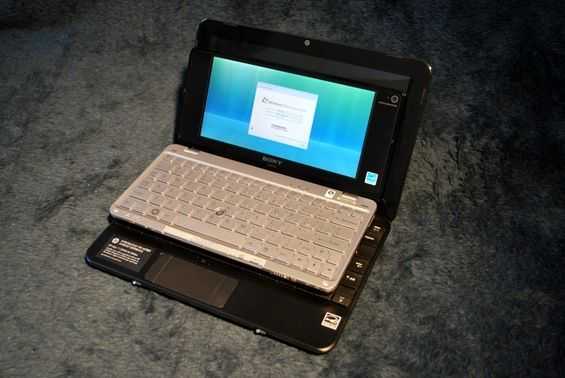 One of the most important aspects of the Sony VAIO P is its tiny size. Sony always pushes the envelope when it comes to seeing how small they can package a full PC. Their VAIO UX line and ultra-portable laptops are a fine example of that.
One of the most important aspects of the Sony VAIO P is its tiny size. Sony always pushes the envelope when it comes to seeing how small they can package a full PC. Their VAIO UX line and ultra-portable laptops are a fine example of that.
Sony has taken the top end of the Atom platform, and put it inside an almost envelope sized package along with some premium hardware. The top end VAIO P that I’m evaluating (thanks to Dynamism) runs at 1.86GHz, with 2GB of RAM, and a 128GB SSD.
People are immediately impressed by the size of the unit, and even more so by the weight. The VAIO P ways 1.4 pounds. One friend saw the tiny computer and simply said “It shouldn’t be that small… inch.
 Making something small doesn’t mean its good, it still has to be usable. Sony designed the entire device by starting with the keyboard first and moving on from there. That explains the strange aspect ratio of the screen (2.08:1). They crafted the smallest usable keyboard they could to establish the footprint of the device, then attached a screen.
Making something small doesn’t mean its good, it still has to be usable. Sony designed the entire device by starting with the keyboard first and moving on from there. That explains the strange aspect ratio of the screen (2.08:1). They crafted the smallest usable keyboard they could to establish the footprint of the device, then attached a screen.
Lets talk about the screen. The screen’s thickness is definitely best measure in millimeters. It is really thin and really light. There is a webcam built into the bezel of the screen on the right side. I really like the level of hinge strength that they established with the VAIO P. In my opinion, the best hinge strength is a level that doesn’t allow the body of the device to be lifted up while you try to get the screen open. On the VAIO P it is nearly a perfect example of that description. One you give the screen a little nudge, you can grab if from its farthest point from the body and open without even tipping the body up. The best part about this is that because the screen is so light, there is no wiggle from the body of the device, despite the low hinge strength. The hinge gets tighter right as the screen closes which keeps it shut when folded down.
(Continue Reading on page 2…)
Pages: 1 2











Initial hardware impressions – Sony VAIO P http://www.umpcportal.com/?p=6290
Please keep up the good work Steve, looking forward to reading more about the P Series, even though I won’t ever get one unless the price falls dramatically.
Thanks.
Ben,
Hope you don’t get irritated with people attributing your work to Steve.
Possibly the name that is at the top needs to be a bit clearer.
Haha, it’s ok Vakeros, at least if people are mistaking my posts as being written by Steve, then I know I’m doing Steve-quality posts right? : )
Right :-D
Steve definitely is the heart of UMPC Portal, so be mistaken for Steve is some kind of compliment :-P
BEN,
You stressed the importance of the VAIO P’s tiny size. On the other hand, on March 6, you ruled that “despite all the marketing that tried to convince us that the VAIO P is pocketable, it is not.†Your friend, impressed, exclaimed “It shouldn’t be that small…,†but another reader said “I really like that computer but am concerned about the portability,†and “…if you can not carry it in that pocket then it must be carried in a bag. If you need to carry it in a bag then it is not such a great advantage compared to carrying other even larger computers to me.â€
It IS all about form factor: this whole portal is about “highly portable computers (that’s why we call them Ultra Mobile PCs),†as you expressively made the point. A crucial factor you will have to consider is shock protection, or “mobility [might not] translate to more fun and flexibility.†We’re not talking of rugged UMPCs that function underwater, but of devices that are mobile enough to get there. I broke two Psion 5 screens—one on the downhill bike, the other on snowboard. Today I always carry a hard case: for the Nokia Communicator I simply use a (free) hard case for sunglasses; I had one for the Psion too, but it added to the pocket-size requirements—you will have to figure that in when adjudicating on portability, and might as well paraphrase the conclusion that “making something small doesn’t mean it’s good, it still has to be PORTABLE.â€
I do not agree that “if you need to carry it in a bag then it is not such a great advantage†since there are bags and bags, especially today, when “regardless of the prominence of the Fanny Pack in Weird Al Yankovic’s ‘White and Nerdy…’ it’s impossible to ignore the fact that Fanny Packs are making a comeback,†when “Givenchy and Burberry sent luxurious versions of the hip-grazing bag down their spring runways,†and, thankfully, “today’s packs are different from the bulky butt bags of yore—sleeker and more stylish.†This brings us to the pivotal question on VAIO P’s poratability: does the VAIO’s extra width [Compared to Everun Note’s—which is, according to Jenn, also touch-typable, but, unfortunately, thicker and heavier.], combined with its sleek profile, translate into unacceptable screen-cracking risk, crippling thus its mobility potential?
Interesting points you made here. I’ll stand by what I said, the VAIO P is not Pocketable. That doesn’t mean it isn’t very thin an light though. It is very easy to carry around, would definitely not add a lot of weight to a woman’s purse, which she might already carry. Soild state versions of the device make it feel more safe when you want to tote it around, especially because you can run around even while its on and not worry to much about the parts inside (as long as you aren’t dropping it). One thing that none of us have factored into our definitions of pocketable or portable (in this discussion at least), is price. Price definitely has an effect on how willing you might be to toss it into a bag, or bring it with you on a potentially computer dangerous trip (camping?). When the VAIO P starts around $1000, and works its way up from there, I think those of us not taking baths in money will be very careful with the device.
The VAIO P is a point A to point B kind of device. You take it from point A easily, and use it at point B. As opposed to some devices which are designed to be used during the trip from A to B.
As for the Everun Note. While I haven’t used one, I would imagine that the keys are touch-typable, but don’t necessarily offer the full typing experience. What I mean is that you still use your fingers to type, but might need to alter your typing style to use less fingers so you aren’t so cluttered. On the VAIO P, the keyboard is at a size in which you shouldn’t really have to alter your typing, you just sit down and type like normal. Aside from the issues I mentioned above, this is usually the case.
I agree that if a computer requires a bag to carry it is not very mobile and definately not pocketable. To me there is a big need for a basic computer that has a touch type keyboard and is pocket size. But to clarify pocket size I mean the largest one pocket most people have, the inside jacket pocket. That pocket can handle a device about 4.25″ x 7.5″ x 1″ roughly.
The Sony P is too wide to easily fit in that pocket so is the Everrun as both are about 4.5-4.6″ in width. Also the Sony P is too long to me. Look at past devices like the Psion 5mx at 3.6″ x 6.9″ it had a unique keyboard that expanded a bit and provoided good touch type keyboard input. Thus to me a device a bit larger but still within the limitations of an inside jacket pocket can be created. There are millions of business users whom would buy such a device even at $1000 or even more but so far not one such computer has ever been made.
I am ok with adjusting my typing a little by getting used to less space between my fingers but essentially inputing the same as a normal keyboard. To me the ability for it to be carried in a inside jacket pocket is the key.
I think they could have reduced the width so that is was just a tiny bit narrower say 4″ to 4.25″ so it would slide easily in most large pockets. Also a functional keyboard does not need to be that long; a keyboard that was 7″ to 8″ would be fine. Remember the Psion 5mx it was only 6.9″ long and 3.6″ wide yet had a great easy to use keyboard. I do agree if it must be carried in any bag it is not mobile enough for me. I want a basic laptop in my pocket yet long enough so it would provide good input like the Psion 5mx did but only running Windows. I think the next Sony P should be about 4.25″ x 7.5″ x 1″ in size.
I’ve had a U810 and still have an SC3, which was effectively replaced by my Vaio P. Yes, the U810 is much narrower, but it still wasn’t what one might call conveniently pocketable. I personally don’t want a device that IS pocketable because after having two devices where I had to modify my typing style to touch type, which I was able to do, and now having a device with a wonderful, comfortable keyboard, I wouldn’t want to go back. Besides, being compelled to wear something with pockets big enough for a 4.25″x7.5″x1″ device is far more restrictive to me than carrying a bag, of which I have many. My Vaio P fits in all of them and is as light as the U810. I might not mind carrying a bag so much partly because I have carried them for a long time, usually with mobile phone, PDA, IR or BT keyboard, etc. in them.
It would be cool to see the old Jornada 720 form factor resurrected, which I think would fit in the dimensions given.
With many netbooks able to “run” Mac OS X, one way or another, I wonder if anyone has tried installing Mac OS X on it, or has any cookbook on how to do it, and what works or what doesn’t? hmmm….
Continued thanks for the review of the P.